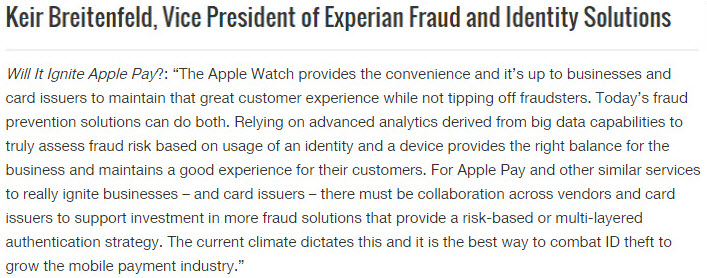Latest Posts

Apple Pay fraud solution Apple Pay is here and so are increased fraud exposures, confirmed losses, and customer experience challenges among card issuers. The exposure associated with the provisioning of credit and debit cards to the Apple Pay application was in time expected as fraudsters are the first group to find weaknesses. Evidence from issuers and analyst reports points to fraud as the result of established credit/debit cards compromised through data breaches or other means that are being enrolled into Apple Pay accounts – and being used to make large value purchases at large merchants. Keir Breitenfeld, our vice president of Fraud and Identity solutions said as much in a recent PYMNTS.com story where he was quoted about whether the Apple Watch will help grown Apple Pay. The challenge is that card issuers have no real controls over the provisioning or enrollment process so they currently only have an opportunity to authenticate their cardholder, but not the provisioning device. Fraud exposure can lie within call centers and online existing customer treatment channels due to: Identity theft and account takeover based on breach activity. Use of counterfeit or breached card data. Call center authentication process inadequacies. Capacity and customer experience pressures driving human error or subjectively lax due diligence. Existing customer/account authentication practices not tuned to this emerging scheme and level of risk. The good news is that positive improvements have been proven with bolstering risk-based authentication at the card provisioning process points by comparing the inbound provisioning device to the device that is on file for the cardholder account. This, in combination with traditional identity risk analytics, verifications, knowledge-based authentication, and holistic decisioning policies vastly improve the view afforded to card issuers for layered process point decisioning. Learn more on why emerging channels, like mobile payments, call for advanced fraud identification techniques.

The follow blog is by Kyle Enger, Executive Vice President of Finagraph With the surge of alternative lenders, competition among banks is stronger than ever. But what exactly does that mean for the everyday banker? It means business owners want more. If you’re only meeting your clients once a year on a renewal, it’s not good enough. In order to take your customer service to the next level, you need to become a trusted advisor. Someone who understands where your clients are going and how to help them get there. If you’re not investing in your clients’ business by taking the following actions, they may have one foot out the door. 1. Understand your clients’ business One of the biggest complaints from business owners is that bankers simply don’t understand their business. A good commercial banker should be well-versed in their borrower’s company, competitors and the industry. They should be willing to get to know their business, commit to them, stop by to check-in and provide a proactive plan to avoid future risks. 2. Utilize technology for your benefit The majority of recent bank innovations have been used to make the customer experience more convenient, but not necessarily the more helpful. We’ve seen everything from mobile remote deposit capture to online banking to mobile payments – all of which are keeping customers from interacting with the bank. Contrary to what many think, technology can be used to create strong relationships by giving bankers information about their customers to help serve them better. Using new software programs, bankers can see information like the current ratio, quick ratio, debt-to-equity, gross margin, net margin and ROI within seconds. 3. Heighten financial acumen Banks have access to a vast amount of customer financial data, but sometimes fail to use this information to its full potential. With insight into consumer purchasing behavior and business’ financial history, banks should be able to cater products and services to clients in a personalized manner. However, many lenders walk into prospect meetings without knowing much about the business. Their mode of operation is solely focused on trying to secure new clients by building rapport – they are what we call surface bankers. A good banker will educate clients on what they need to know such as equity, inventory, cash flow, retirement planning and sweep accounting. They should also know about new technology and consult borrowers on intermediate financing, terming out loans that are not revolving, or locking in with low interest rates. Following, they will bring in the right specialist to match the product according to their clients’ needs. 4. Go beyond the price Many business owners make the mistake of comparing banks based on cost, but the value of a healthy banking relationship and a financial guide is priceless. So many bankers these days are application gatherers working on a transactional basis, but that’s not what business owners need. They need to stop looking at the short-term convenience of brands, price and location, and start considering the long-term effects a trusted financial advisor can make on their business. 5. A partner in your business, not a banker “Sixty percent of businesses are misfinanced using short-term money for long-term use,” according to the CEB Business Banking Board. In other words, there are many qualified candidates in need of a trusting banker to help them succeed. Unbeknownst to many business owners, bankers actually want to make loans and help their clients’ business grow. Making this known is the baseline in building a strong foundation for the future of your career. Just remember to ask yourself – am I being business-centric or bank-centric? To view the original blog posting, click here. To read more about the collaboration between Experian and Finagraph, click here.

Gift card fraud Gift cards have risen in popularity over the last few years— National Retail Federation anticipated more than $31B in gift card sales during the 2014 holiday season alone. Gift cards are the most requested gift item, and they have been for eight years in a row. Total gift card sales for 2014 were anticipated to top $100 Billion. Gift cards are a practical gift – the purchaser can let the recipient pick exactly what they want, eliminating the worry of picking something that doesn’t fit right, that is a duplicate, or something that the recipient just might not want. They are also incredibly convenient, quick, and easy to purchase. The stigma behind gift cards is starting to fade, and it no longer seems as though they are an impersonal gifting option. Additionally, the type of gift cards available has expanded greatly in the last few years. If you are of the procrastinating nature, there are eGift Cards or eCertificates, which can be emailed in a matter of minutes to the recipient. If you are truly unsure what to purchase altogether, you can give an open-loop card, which are usually branded by Visa, MasterCard, and American Express, and can be used anywhere their logo appears. It also seems like a quick win for merchants to carry gift cards. The overhead cost to store them is extremely low because a small box of gift cards takes up very little space. When customers come in to redeem their GC, they usually spend more than the original value of the card itself, thus allowing for additional revenue capture. Something else that merchants have started doing in this big data world we live in is tying gift cards to consumer loyalty programs. Reloadable cards are now linked to a specific customer, who can also tie their credit card to the account, which is automatically charged once their account is below a pre-defined threshold. These new consumer loyalty accounts can be used to track spending history, tailor offers to the specific customer, and continue to expand on the immersive brand experience. Recently, a certain Mexican-themed fast food establishment launched their new mobile app; in the app, you could pre-order food, send and redeem eGCs, and find the nearest location. I don’t even eat at this establishment, but the innovation of their app was so enticing that I installed it the morning it came out, purchased an eGC for my husband, and pre-ordered breakfast. It was extremely easy and convenient, and I got a free taco! Now they have my soul. Okay, maybe not my soul, but they have my credit card data, purchasing preferences, device information, and location, which is almost the same thing at this point. After the experience I found myself asking why other merchants haven’t already done this or why it hasn’t taken off yet. This is a great example of how gift cards and emerging technology are being used as a marketing tool to entice consumers to build up a customer base. In the rare instance that a gift recipient does not actually find value in their gift card (the horror!) there’s a multitude of options for trading them in or redeeming for cash. Some well-known websites for trade-in are Giftcard Granny, Card Hub, and raise.com; it’s also incredibly common to find discounted GCs for sale on eBay, Craigslist, and Facebook groups. A couple familiar names that have recently entered into the mix are Wal-Mart and CoinStar. You can now exchange your physical gift card for cash at a specific CoinStar machines, and if you don’t feel like leaving your home, you can exchange your card online with Wal-Mart, and they will provide you with a Wal-Mart gift card that can be redeemed online or in stores. It’s such common practice that you can find articles on this topic on local, national, and 24-hour news websites. This tremendous revenue booster does not come free of risk, however. We know that fraudsters are clever and opportunistic. They will penetrate every weakness possible and take advantage of programs that are being used to enhance the consumer experience. But are they really stealing all these gift cards for personal gain and taking all of their friends out to their favorite local coffee shop for free drinks? Stay tuned for the second part of this blog that talks more about the fraud risks associated with gift cards and what you can do to mitigate them. Please note: *The use of GC/eGC is used interchangeably.

By: Mike Horrocks Experian has announced a new agreement with Finagraph, a best-in-class automated financial intelligence tool provider, to provide the banking industry with software to evaluate small business financials faster. Loan automation is key in pulling together data in a meaningful manner and this bank offering will provide consistent formatted financials for easier lending assessment. Finagraph’s automated financial intelligence tool delivers advanced analytics and data verification that presents small business financial information in a consistent format, making it easier for lenders to understand the commercial customer’s business. Experian’s portfolio risk management platform addresses the overall risks and opportunities within a loan portfolio. The company’s relationship lending platform provides a framework to automate, integrate and streamline commercial lending processes, including small and medium-sized enterprise and commercial lending. Both data-driven systems are designed to accommodate and integrate existing bank processes saving time which results in improved client engagement “Finagraph connects bankers and businesses in a data-driven way that leads to better insights that strengthens customer relationships,” said John Watts, Experian Decision Analytics director of product management. “Together we are helping our banking clients deliver the trusted advisor experience their business customers desire in a new industry-leading way.” “The lending landscape is rapidly changing. With new competitors entering the space, banks need innovative tools that allow them to maintain an advantage,” said James Walter, CEO and President of Finagraph. “We are excited about the way that our collaboration with Experian’s Baker Hill Advisor gives banks an edge by enabling them to connect with their clients in a meaningful way. Together we are hoping to empower a new generation of trusted advisors.” Learn more about our portfolio risk management and lending solutions and for more information on Finagraph please visit www.finagraph.com.

Deposit accounts for everyone Over the last several years, the Consumer Financial Protection Bureau (CFPB) has, not so quietly, been actively pushing for changes in how banks decision applicants for new checking accounts. Recent activity by the CFPB is accelerating the pace of this change for those managing deposits-gathering activities within regulated financial institutions. It is imperative banks begin adopting modern technology and product strategies that are designed for a digital age instead of an age before the internet even existed. In October 2014, the CFPB hosted the Forum On Access To Checking Accounts to push for more transparent account opening procedures, suggesting that bank’s use of “blacklists” that effectively “exclude” applicants from opening a transaction account are too opaque. Current regulatory trends are increasingly signaling the need for banks to bring checking account originations strategies into the 21st century as I indicated in Banking in the 21st Century. The operations and technology implications for banks must include modernizing the approach to account opening that goes beyond using different decision data to do “the same old thing” that only partially addresses broader concerns from consumers and regulators. Product features attached to check accounts, such as overdraft shadow limits, can be offered to consumers where this liquidity feature matches what the customer can afford. Banking innovation calls for deposit gatherers to find more ways to approve a basic transaction account, such as a checking account, that considers the consumer’s ability to repay and limit approving overdraft features for some checking accounts even if the consumer opts in. This doesn’t mean banks cannot use risk management principles in assessing which customers get that added liquidity management functionality attached to a checking account. It just means that overdraft should be one part of the total customer level exposure the bank considers in the risk assessment process. The looming regulatory impacts to overdraft fees, seemingly predictable, will further reduce bank revenue in an industry that has been hit hard over the last decade. Prudent financial institutions should begin managing the impact of additional lost fee revenue now and do it in a way that customers and regulators will appreciate. The CFPB has been signaling other looming changes for check account regulations, likely to accelerate throughout 2015, and portend further large impacts to bank overdraft revenue. Foreshadowing this change are the 2013 overdraft study by the CFPB and the proposed rules for prepaid cards published for commentary in December 2014 where prepaid account overdraft is “subject to rules governing credit cards under TILA, EFTA, and their implementing regulations”. That’s right, the CFPB has concluded overdraft for prepaid cards are the same as a loan falling under Reg Z. If the interpretation is applied to checking account debit card overdraft rules, it would effectively turn overdraft fees into finance charges and eliminate a huge portion of remaining profitability for banks from those fees. The good news for banks is that the solution for the new deposits paradigm is accomplished by bringing retail banking platforms into the 21st century that leverage the ability to set exposure for customers at the client level and apportioned to products or features such as overdraft. Proactively managing regulatory change, that is predictable and sure to come, includes banks considering the affordability of consumers and offering products that match the consumer’s needs and ability to repay. The risk decision is not different for unsecured lending in credit cards or for overdraft limits attached to a checking account. Banks becoming more innovative by offering checking accounts enabling consumers more flexible and transparent liquidity management functionality at a reasonable price will differentiate themselves in the market place and with regulatory bodies such as the CFPB. Conducting a capabilities assessment, or business review, to assess product innovation options like combining digital lines of credit with check accounts, will inform your business what you should do to maintain customer profitability. I recommend three steps to begin the change process and proactively manage through the deposit industry regulatory changes that lay ahead: First, assess the impacts of potential lost fees if current overdraft fees are further limited or eliminated and quantify what that means to your product profitability. Second, begin designing alternative pricing strategies, product offerings and underwriting strategies that allow you to set total exposure at a client level and apportion this exposure across lending products that includes overdraft lines and is done in a way that it is transparent to your customers and aligns to what they can afford. Third, but can be done in parallel with steps one and two, begin capability assessments of your financial institution’s core bank decision platform that is used to open and manage customer accounts to ensure your technology is prepared to handle future mandatory regulatory requirements without driving all your customers to your competitors. It is a given that change is inevitable. Deposit organizations are well served to manage this current shift in regulatory policy related to checking account acquisitions in a way consistent with guaranteeing your bank’s competitive advantage. Banks can stay out front of competitors by offering transparent and relevant financial products consumers will be drawn to buy and can’t afford to live without! Thank you for following my blog and insights in DDA best practices. Please accept my invitation to participate in a short market study. Click here to participate. Participants in this 5 minute survey will receive a copy of the results as a token of appreciation.

We recently issued our Q4 2014 Experian-Oliver Wyman Market Intelligence Report that covers consumer economic trends and found that overall bankcard delinquencies (60 days past due (DPD) and greater) came in at a low 1.79% for Q4 2014. It is interesting to note the disparity when analyzing delinquency by annual spend level. Those spending $100,000 or more per year on credit cards had the lowest delinquency rate at 0.43%, while those spending $5,000 or less annually had the highest delinquency rate at 3.58%. Percent of balances 60+ DPD delinquent by annual credit card spend level* $100,000+ 0.43% $50,001—$100,000 0.51% $25,001—$50,000 0.75% $10,001—$25,000 1.23% $5,001—$10,000 1.87% <= $5,000 3.58% Overall 1.79% Card issuers can target the right customers with the right offer and drive increased portfolio profitability by using unique tools that provide insight into consumer preferences, income profiles and spend metrics. Find out more on how to discover key steps to developing a profitable bankcard campaign.

Reputational impact of fraud It’s all over the news. Hackers are compromising personal information and using that to access customer accounts. It’s critical that organizations have technology in place to distinguish valid customers from fraudsters as quickly as possible. The impact of fraud on the customer relationship requires more elaborate and accurate fraud prevention. Customers have a legitimate expectation that the institutions with which they do business will safeguard their identities, accounts and sensitive data. When fraud or a data breach occurs, that trust can be broken. All the work an institution has done to build its brand image can be damaged suddenly. With the right controls in place, even when customer information is compromised organizations can easily tell the difference between good customers and fraudsters. Listen to what Matt Lane, Experian's 41st Parameter vice president of customer management, says about the reputational impact of fraud theft on an organization: Learn more about the reputational impact of fraud thefts on an organization.

By: Scott Rhode This is the third and last of a three-part blog series focused on the residential solar market looking at; 1) the history of solar technology, 2) current trends and financing mechanisms, and finally 3) overcoming market and regulatory challenges with Experian’s help. As we’ve discussed in the two previous blogs, the residential solar industry in the US has experienced tremendous growth and much of that growth is attributed to financing. As the financing offers continue to evolve and mature, there are challenges that the industry faces. The first, and most obvious challenge, is that the Solar Investment Tax Credit is set to expire on December 31st, 2016. (To be clear, the credit is not eliminated on Dec. 31, 2016, it is simply planned to be reduced to 10%) Given the state of affairs in Washington, it is unlikely that the tax credit will get extended. This is unfortunate since this tax credit has been a catalyst for investment in this industry, greatly increasing affordability and adoption from the public. Once this incentive expires, the solar companies will need to acquire capital from more traditional sources (Debt markets, securitization, or other third party financing) to fund their growth since the Tax Equity community may no longer be willing to invest. In addition, the expiration of the credit means that panel manufactures must find ways to reduce the cost of production and that finance and installation companies must lower their customer acquisition cost since they are unsustainable in a post-ITC world. A benefit of moving towards other means of funding is that the sophistication level of pre-screening, scoring, and portfolio management should improve dramatically. Today, the Tax Equity community drives all of the credit strategies and those strategies are actually holding solar companies back because of their simplicity. For example, most of the TE investors require that the customer have a 680 FICO score or better in order to get approval. They do not require a debt to income threshold to be met, nor do they look at other attributes or data points. This overly simplistic approach is meant to keep the TE investor out of difficult conversations of being in the “sub-prime” space; however, it greatly limits growth and it turns away good customers. Additionally, this approach does not consider the “essential use” nature of the product. When a customer becomes seriously delinquent, their panels get disconnected and their costs for energy go up more than the cost of their monthly lease payment. This ensures that, unlike an unsecured loan or credit card, the customer is more likely to pay this obligation since it is actually saving them money. This does not mean that the industry can approve everyone; however, it does mean that, with the right decisioning logic and scorecards, they can go much deeper into the credit pool without taking on huge risks. Another challenge for the industry is the shear rate of growth. There are new players in the market every day and even established firms have a hard time keeping up with the growth. This leaves the individual organization and industry at risk for missing critical compliance steps in their operations. Given that these financial instruments are long term in nature and more consumers are adopting this as a means to get solar, it is only a matter of time before the regulators start to look into the practices and operating processes to ensure that all of the applicable regulations are being followed. The industry, as a whole, needs to ensure that they spend a little money now shoring up their compliance instead of paying a hefty fine later. Finally, what happens at the end of the lease? Many of the large players have taken a conservative approach as to how they price the residual amount at the end of term; however, no one really knows what these assets will be worth in 20 years. While many of the panel manufacturers warrant performance for 25, many panels have a shelf-life of 40 years, so how will consumers and the industry behave? What happens if there is a technological breakthrough in 10 years and those old panels are obsolete? At the moment, the industry’s answer to these questions is to set a very low residual which carries risk. Being too conservative here means that your customer’s payment is higher than it needs to be, pricing yourself out of certain markets where the cost of power is less than 20 cents / kwh. As the lease product continues to mature, more focus and emphasis on residual pricing will need to take place to find the right balance for the Consumer and the finance company. It should be said that while there are risks associated with this industry, all markets and new financing products carry risks. The goal of this particular blog is to highlight some of the larger risks that this industry faces. As these are identified, it is incumbent on the industry and partners of the industry to mitigate these risks so that consumers can continue to realize the power of solar. To close this series, I would be remiss if I didn’t offer up Experian’s Global Consultancy solutions to help address the challenges that the industry faces. Our knowledge of best practices in the financial services industry allows us to help those companies in the solar market grow originations responsibly, meet their regulatory requirements, and manage their long term risks with customers. While we cannot solve the funding issues, we can work with organizations and the tax equity community to educate them on the power of decisioning beyond a simple “one-size fits all” score. In addition, our products and data allow for flexibility and certainty, giving the industry an edge in acquiring new customers in a more efficient and less expensive manner. Finally, we can help provide advice and best practices in decisioning, risk management, and regulatory compliance so that the industry can continue to grow and thrive. All in all, we are advocates for the industry and can bring tremendous expertise and experience to help ensure continued success. Solar Financing – The current and future catalyst behind the booming residential solar market (Part II) Solar Financing — The current and future catalyst behind the booming residential solar market (Part I)

By: Mike Horrocks I was raised in an underbanked home! I have known this for a long time, but it feels great to say it and be proud of it. I was raised in Neola, Utah, a small cattle ranching community of at the time 500 or so people. I don’t recall as a kid ever feeling poor or on the edge financially, in fact it was quite the opposite. When I was a freshman in college I got my own banking accounts and my first major credit card that gave cash back, it all just seemed normal. I recall showing my dad my new found financial life. The concept of getting cash back for purchases was something he wanted in on. He made the call to get his own card and within minutes the representative on the other end of the call asked if I was willing to co-sign for my dad because he did not have a thick enough credit file. At this point of my dad’s life, he had developed and sold a couple of businesses, bought and managed a successful angus cattle ranch - but he had done most of it in cash and so he was “off the grid”. When I co – signed for my dad, it hit me, in terms of the banking system that I was studying at the university, we were an underbanked family! So what are the lessons learned here for a banker today: Underbanked does not equal poor. I never felt poor, the family business was going great, and my dad was always able to meet any obligation or need for the ranch and us kids. Bankers need to know their customers. When my dad did need access to more capital, there was a great banker at Zions Bank that knew my dad and stood by him even though the traditional file was thin. So know your customers by all means (traditional credit, alternative data, etc.) Don’t forget the family. By this I mean the associated products and what they can mean to the overall customer picture and relationship. Know what risks and opportunities are there as you try to optimize the relationship. If you want to read some more, American Banker just published a great set of articles on including consumers and how to retain them - it is worth a quick review. Don’t let great customers like my dad go through your business development net. Attract them, nurture them and build great relationships with them.

By: Barbara Rivera Every day, 2.5 quintillion bytes of data are created – in fact, 90% of the world’s data was created in only the last few years. With the staggering amount of data available, we have an unprecedented opportunity to uncover new insights and improve the way our world functions. The implications of these new capabilities are perhaps nowhere else as crucial as within our government. Public sector officials carry the great responsibility of conducting complex missions that directly affect our communities, our economy, and our nation’s future. The ability to make more informed, insightful choices and better decisions is paramount. Especially at a time of broader global unrest and uncertainty, Americans rely on our government to be transparent, fair, ready and to make the right decisions – our trust is in the hands of our elected officials and public servants. Data alone is not enough to inform and affect change. However, with integrated information assets, insightful analysts and collaborative processes, data can be transformed into something meaningful and actionable. Our government has already begun leveraging data for good across agencies and varied missions, with more potential unlocked each day. Local governments like Orange County, California are utilizing data through address verification services to keep their voting lists accurate – ensuring the integrity of elections and saving the taxpayers thousands of dollars otherwise wasted on mailings to outdated lists. The Orange County Registrar of Voters – the fifth largest voting jurisdiction in the county – has been able to cancel 40,000 voting records, with an estimated savings of $94,000 expected from 2012 through 2016. The examples are numerous and growing: A suite of optimization tools helps states find non-custodial parents, determine their capacity and likelihood to pay child support, and trigger alerts with new critical information, maximizing the likelihood of payment and recovery, ultimately improving the welfare of children and reducing poverty More than 150 state, county and local law enforcement agencies leverage data to help identify persons of interest, conduct background screening for employees and contractors and provide financial backgrounds for criminal investigations, ensuring our continued safety By using the power of data to manage user authentication, credentials and access controls, the government is working harder – and smarter – to protect our security The government is leveraging verified commercial data to help agencies validate the fiscal responsibility of potential contractors and monitor existing contractors, which helps provide transparency and reduce risk By using data and analytics to authenticate applicants and validate financial data, the government is ensuring access to benefits for those who meet eligibility requirements, while at the same time reducing fraud Private sector partners are supporting municipal efforts to improve financial stability in households by providing the current credit standing of consumers and monitoring overall changes in financial behaviors over time, to help counsel and educate citizens And that’s only the beginning. The possibilities are endless – from healthcare to finance to energy – data can be leveraged for the advancement of our society. It even happens behind the scenes, working to protect information in ways most citizens never realize. Data insights are used to ensure citizens have secure online access to their information – ever see those randomized, personal questions? That’s data at work. The same technology is the de facto ID Proofing standard for the VA and CMS. How does it all work? By combing through the data carefully, putting it in context, looking at it in new ways, and thinking about what all this information really means. Much of this is made possible through public-private partnerships between the government and companies like Experian. So the next time someone complains about the slow pace of government, let them know the truth is government is moving quickly, leveraging data and private sector partnerships to uncover new insights that impact the greater good.

A comprehensive customer-experience strategy can give companies the competitive edge needed in a market where price, products and service can no longer be considered effective differentiators. Capturing customer insight is critical to developing a sound customer experience strategy, yet research shows that while 85 percent of companies collect such feedback, only 15 percent take action on it as part of their strategy. Delivering a consistently successful experience across all channels leads to more customers who buy more, stay longer and cost less to serve. Companies can drive value and loyalty by taking aggressive steps to develop an in-depth understanding of their customers and then plan, design and implement a structured, comprehensive customer experience program. The New Customer Experience – An Experian White Paper

According to the latest research by Experian Marketing Services, nearly a third of all Americans use at least one type of smart or Internet-connected device* (wearable fitness tracker, smart watch, smart TV, smart home technology). While smart TVs have generated the most consumer interest, at least 14 percent of homes are smart homes (connected lights, locks, thermostats, window coverings, etc). Further, the smart home device category saw the most growth during the holiday season, with interest increasing 54 percent from November to December 2014. By 2020, the number of Internet-connected devices is expected to grow to 26 billion, creating new revenue streams and opportunities for marketers. Understanding how to reach customers in this newly connected world and creating resonant messages will be critical to future business success. Source: Experian Marketing Services, The Internet of Things: Opportunities through the rise in smart devices *Does not include smartphones, tablets or computers

According to a recent Experian credit-trend analysis, bankcard originations for all of 2014 totaled $318.7 billion, a 20 percent increase over 2013 originations of $266.5 billion. The growth trend demonstrates the importance of staying abreast of the latest credit trends in order to adjust lending strategies and capitalize on areas of opportunity. Discover key steps to developing a profitable bankcard campaign.

The experience of being a victim of data breaches has created a shift in consumer behavior and attitude over the past year. A recent Ponemon Institute study found that more than one-third of consumers ignored data breach notification letters, taking no action to protect themselves against fraud. To combat data breach fatigue, companies should communicate with customers sincerely and avoid treating the notification process as a compliance issue. Notification letters should include an apology, a clear explanation of what happened and why, and steps consumers can take to protect themselves from fraud. 2015 Data Breach Industry Forecast

While marketers typically spend vast amounts of money to increase customer acquisitions, fraud prevention can undercut those efforts. According to a recent 41st Parameter® study, average card-not-present declines represent 15 percent of all transactions; however, one to three percent of those declined transactions turn out to be false positives, equating to 1.2 billion dollars in lost revenue annually. Marketers can avoid unnecessary declines and create a seamless customer experience by communicating campaign plans to the fraud-risk team early on and coordinating marketing and fraud-prevention efforts. Download Experian’s latest fraud prevention report. Report: Holiday Marketing & Fraud